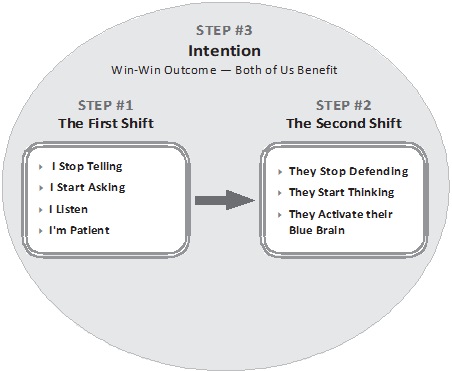02 Jul Create the Space for Win-Win Decision Making
If we want to create win-win outcomes, we have to create the environment for win-win decisions. To do this, there are two critical actions we need to take.
First, we need to create the “potential” space, within which both parties are comfortable exploring issues and making a decision.
Second, we need to be clear on our intention – do we truly want to achieve a win-win outcome or are we merely trying to force the other party into what will primarily meet our interests.
Let’s look first at why we create a “potential” space. We explore this idea in Chapter 3 of BrainFishing under the question “What psychology is there behind all this BrainFishing stuff?”.
Here is a snippet from that chapter:
This is the idea of creating a “potential space” within which rich and complex conversations can take place. The term “potential space” was coined originally by Donald Winnicott, a British psychologist who worked closely with mothers and babies. He believed that it was the role of the mother to create the space, the “potential space”, within which her child could safely explore the development of their own identity.
This is exactly what happens when we are BrainFishing, only on an adult level. We are creating – and holding – the space within which it is safe to think, to explore new ideas, to understand each other without judgment. In this “potential space” we can find, through dialogue and the exchange of both common and competing interests, the best solution to the problem, the best path to build a stronger relationship, the best solution for both parties.
We create this space by asking questions so that both parties – including us! – can explore and define our interests and find that collaborative mix of common and competing interests that creates a win-win outcome. This is full Blue Brain thinking. If we start telling telling telling rather than a combination of asking and understanding, the other party will retreat into their Red Brain, and both parties will stop listening. Not only will outcomes be sub-optimal but the long-term relationship will be weakened.
Creating and holding the potential space is both a respectful and essential way to achieving optimal win-win outcomes. And we do this through good questionings, strong listening and the intention to deeply understand the other party. Check out further thinking on this in Chapter 3 of BrainFishing.
The second critical factor in achieving these outcomes is our own intention. Ask yourself: Do I truly want to achieve an outcome that meets both parties’ interests? Or is my intention actually to manipulate the other party into what I want and I don’t really care if their interests are met?
We show the 3 Steps that are crucial to creating win-win outcomes in Chapter One of BrainFishing:

- Step #1: The first step is to prepare and ask questions that are focused on their interests. We stop telling, start asking questions, and listening. This is the First Shift.
- Step #2: The second step is created by the first – when we shift to asking and listening, we create the Second Shift in the other party – they stop defending, start listening and engage their Blue Brain, like us.
- Step #3: The third step is to clarify our own intentions: I will only be satisfied if enough of both parties’ interests are met to create a win-win outcome. Anything less will not be enough. To accomplish this, I need to understand and look out for both my interests and the other party’s interests. ‘We try to deeply understand the Results they need, the Process that will seem fair and logical to them, and the underlying Emotions that will drive their decisions’.
These three Interests – Results, Process, Emotions – are explored more thoroughly in Chapter Two of BrainFishing on page 42. These three steps create the “potential” space, the space where we have the very real potential to create win-win outcomes.

